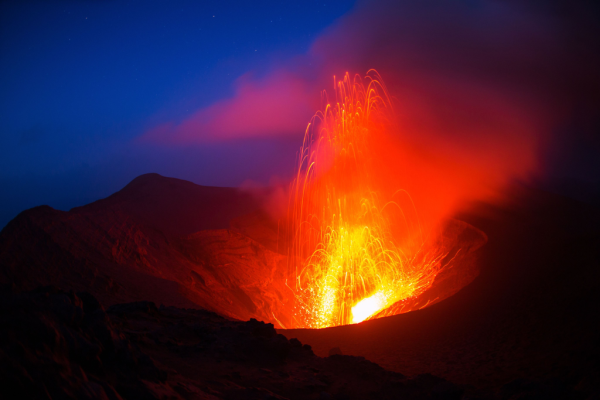Mauna Loa, the world’s largest active volcano, began erupting at about 11:30 p.m. Sunday, November 27, the first eruption since 1984. No recent eruptions of the volcano have caused fatalities, but eruptions in 1926 and 1950 destroyed villages, and the city of Hilo is partly built on lava flows from the late 19th century.
The eruption is confined to Moku‘āweoweo, the summit caldera of the 13,100-foot volcano, the Hawaii Volcano Observatory reported. Lava has overflowed the caldera but does not pose a threat to populated areas at the moment, emergency officials said Monday, November 28. In the meantime, emergency officials in Hawaii are warning residents near Mauna Loa of things like “Vog,” and “Pele’s Hair.” Which causes many of us to wonder, just what the heck is Vog and Pele’s Hair, anyway?
Vog is a form of air pollution that results when sulfur dioxide and other gases and particles emitted by an erupting volcano react with oxygen and moisture in the presence of sunlight. The word is a portmanteau of the words “volcanic” and “smog”.
Vog can negatively impact air quality, and experts urge those with respiratory conditions and breathing difficulties to take precautions, like staying indoors with air conditioner or an air purifier. Common symptoms to look out for when exposed to vog include headaches, watery eyes, sore throat, flu-like symptoms, and lack of energy.
Although vog isn’t filling skies over Oahu, Professor Stephen Businger of the University of Hawaii’s Department of Atmospheric Sciences said emission could travel across the islands depending on wind conditions. “Even though there’s a lot of vog entering the atmosphere, their forecast doesn’t really indicate that we’re going to see a lot of it at ground level over the next few days.” said Businger. “The winds are from the south, however, aloft and so the fog is moving northward.”
Additionally, face masks can be effective against particulates ― like falling ash and Pele’s hair, or shards of glass. But they will not protect you against sulfur dioxide, vog or other gases. “The N95s are best they do not get rid of the chemicals unfortunately, though, so it does help with the particulate dust and particles, even Peles hair,” said Straub Allergist and Immunologist Dr. Jeffrey Kam.
Pele’s Hair, a byproduct of volcano eruptions, are thin glass fibers “named after the volcanic deity Pele,” according to the National Park Service. Pele, short for Pelehonuamea, is a Native Hawaiian deity of fire and volcanoes, Hawaii.com reported. According to legend, she dwells at the summit of Kīlauea on Hawaii.
Piles of the long, hair-like fibers can be found near volcanic summits in Hawaii. The fibers resemble “golden mats of hair,” the park service says on a page about the phenomena. “When bubbles of gas near the surface of a lava flow burst, it can stretch the skin of the molten lava into long threads,” the page said.
Strands of Pele’s Hair can stretch up to 2 feet in length but are less than a micron, or .001 millimeters, wide. They are light enough to be picked up and carried by the wind. Pele’s Hair can form mats up to several inches deep. The fragile mats are easily broken, but because they are glass, they can form slivers in the skin or eyes, the agency warned. “Caution around the fibers is necessary to avoid injury from the slivers,” the agency advised. Birds sometimes use the fibers as part of their nests, however.
—
Photo Credit: StanislavBeloglazov / Shutterstock.com
